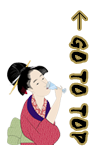Sake manufacturing process
1 Be particular about the rice
The first step in producing sake is rice farming.
Our Kurodo workers cultivate rice paddy fields to produce suitable rice (Hyogo Kitanishiki) for making sake.
Standards define that rice suitable for sake making has a large grain of 25g per 1000 grains.
This rice contains less protein and fat.
When our own rice production is not sufficient to meet demand, we source other first grade grains which have passed strict inspections.
Being particular about each rice grain is the key to making great sake.
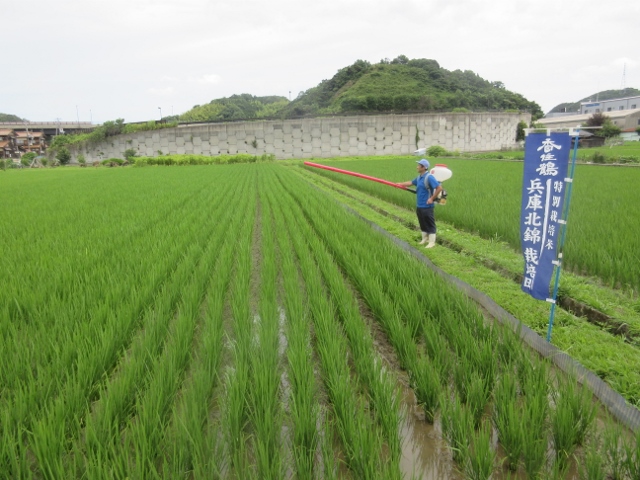
2. Seimai or rice polishing
The brown rice is milled away to remove the bran, embryo and albumen.
Seimai-buai measures the amount of rice remaining after polishing.
Proteins and fats are in the outer layers of the rice grains.
They influence the quality of the sake and are removed slowly and carefully so as to avoid crushing the rice grains during polishing.
This gives sake a more delicate taste.
On the other hand, a high value of Seimai-buai makes it difficult to bring out the rice brand’s unique characteristics and requires additional processing in later stages of sake brewing.
Milling also removes minerals and vitamins that promote fermentation, requiring higher technologies at later stages in the production process.
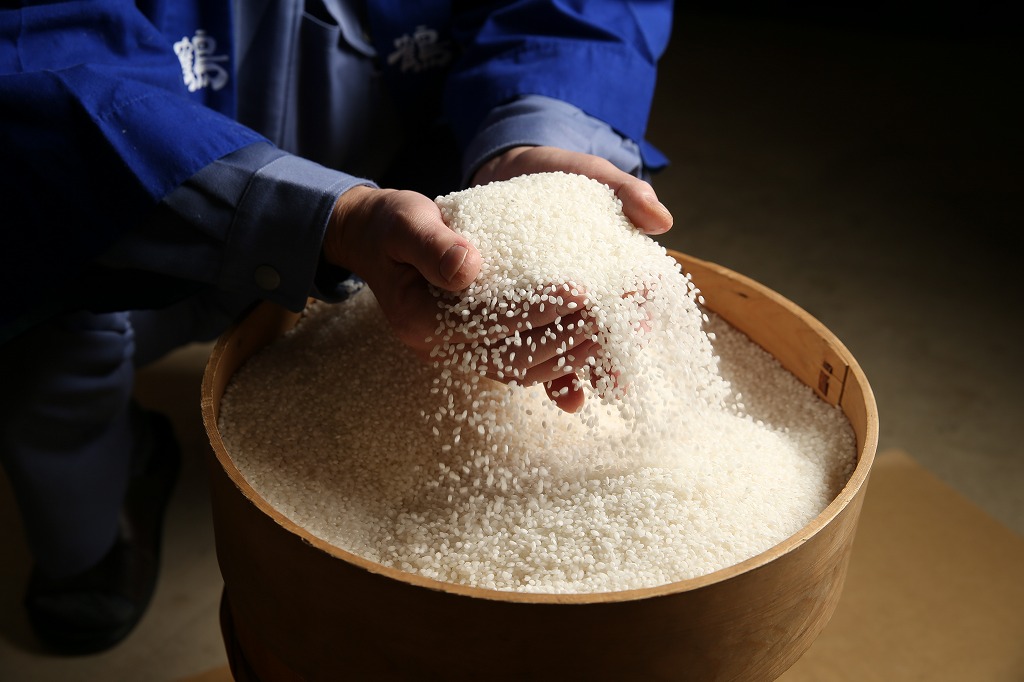
Flow
Sake preparation step 1
Next the polished rice is washed. The water used for the entire sake making processes must be potable and should contain many microorganisms and minerals.
We use water sourced underground, drawn from a 50 meter deep well near the Yada river.
Keeping this water at 15 degrees Celsius at all times is critical to making our Kasumitsuru sake so great. We are indeed fortunate to live in Tajima.
Polishing reduces the rice’s moisture content to approximately 10%, so the rice must be stored for about one month to regain a 15% moisture content.
This timing is determined by the Toji or the chief brewer and their broad experience and skill.
This moisture content adjustment impacts the next process of steaming rice or Mushimai.
Because rice harvests are different each year, the moisture content adjustments also vary.
The Toji is responsible for managing these variances.
The moisture-content-adjusted sakamai or rice used for making sake is steamed at 100 degrees Celsius.
Making koji (malt): The three important preparation steps are malting, Moto and preparation.
Malt microbes are sprinkled onto the steamed rice.
Rice starch changes to glucose by the enzymatic saccharification of the malt microbes.
Malt production continues for 48 hours with hands, maintaining ideal temperature and moisture content throughout, and making sure microbes will not be over-produced.
Making the koji for Daiginjo (see note below) is especially hard work.
For the Toji, this is an exhausting week without sleep and the highlight of this highly skilled profession.
Note: Daiginjo represents the highest quality in sake making.
To classify as Daiginjo, a minimum of 50% of the outer rice layers must be polished away and less than 10% by weight of alcohol can be added.
Also the ginjo making process or Moromi, takes 25 days or longer at low temperature to qualify as Daiginjo.
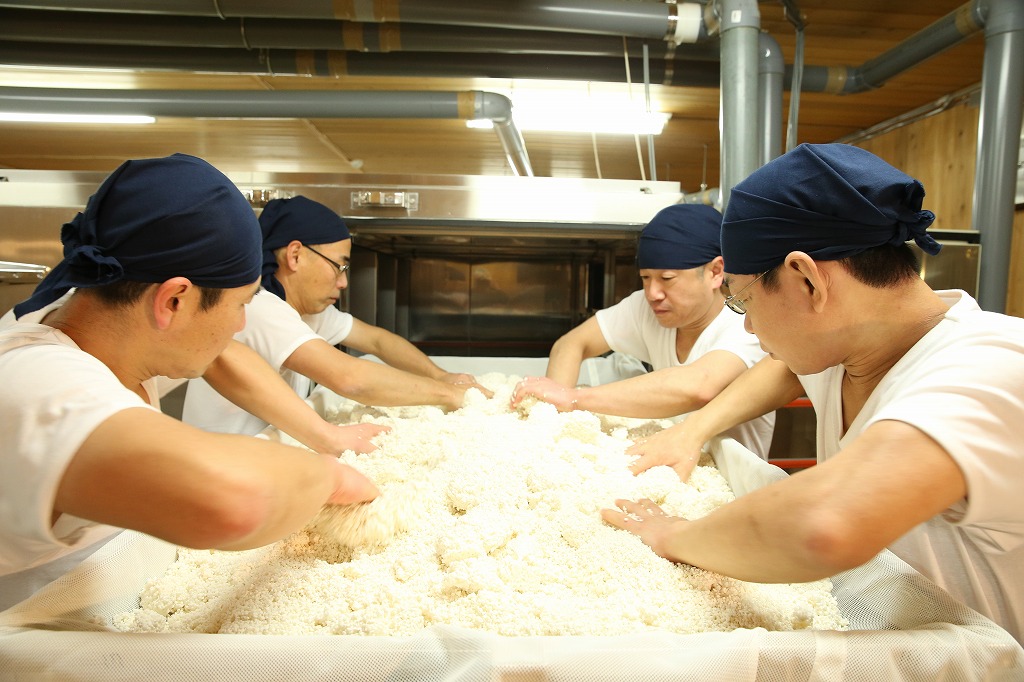
Kimoto making process
The primary ingredients of Shubo (see below), namely malt, steamed rice and water, are put into a wooden tank.
The Toji is stirring and crushing the steamed rice carefully by wooden paddles. This process is called Yamaoroshi.
This process is very time consuming and requires a high degree of skill.
Our company has been conducting this traditional process for long time.
We are proud to affirm that our product Kasumitsuru is made at one of the very few sake breweries that continue to use Kimoto method.
Note: Shubo is made by Mushimai or steamed rice with malt added.
It is the base of Moromi for Japanese sake, also known as Moto.
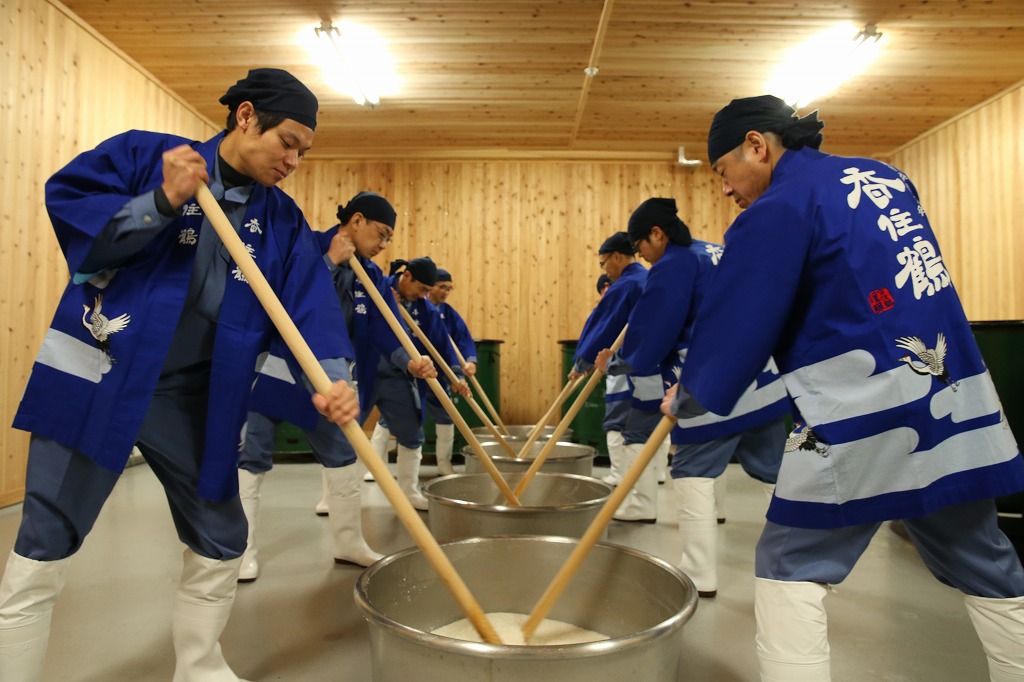
Sake preparation step 2
Shubo, water, malt and steamed rice are put together in three steps.
The temperature and amounts of each ingredients are adjusted throughout.
During these steps, saccharification and alcohol fermentation proceed and the temperature is kept at 15 degrees Celsius by the sixth day.
Meanwhile, the Moromi (see note below) is analyzed frequently to monitor the progress of the sake making processes.
About 20 days after shikomi or preparation, the sake and sake lees are separated by squeezing the unrefined sake through a large machine.
Genshu or unrefined sake is stored in a cool cellar and allowed to mature.
Taste testing determines when products are ready to be delivered.
Note: The staged combination of steamed rice, koji malt, water and Shubo is called Moromi.
When fermentation is complete, a brand new batch of sake is ready.
These are the basic steps in making sake.
Each stage in the process relies on the Toji’s skills and experience to produce an outstanding product.
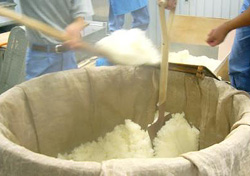
Kasumitsuru Co., Ltd. Corporate Profile
| Founded | 1725 |
| Company Established | 18th December 1945 |
| Capital | 96 million yen |
| Representative | Kazuhiro Fukumoto (10th generation) |
| Employees | 40 (male: 16, female: 24) |
| Business | Sake manufacturing/selling, cultivation of rice for sake brewing |
| Location | 600-2, Kobara, Kasumi-ku, Kami-cho, Mikata-gun Hyogo, 669-6559 |
The birthplace of Kasumi Tsuru Co, Ltd, was Mori, Kasumi-ku, Kami-cho, Mikata-gun, Hyogo, near the company’s current location. Mori is also the home of Kameizan Daijyoji temple, where a collection of 165 paintings on fusuma sliding doors is maintained. All of these nihon-ga (Japanese-style paintings) were painted by the famous Okyo Maruyama (1733-1795) and his pupils in the late Edo period and have been designated as national important cultural properties of Japan. Thus, the temple is also called Okyo temple. It is said that Okyo and his pupils, who were far from their homes in Kyoto, received great comfort from drinking Kasumi Tsuru sake.
It has been 298 years since Kasumi Tsuru was founded in 1725. In December 1945, Kasumi Tsuru merged with three other breweries in the area. Mr. Seizo Fukumoto from Fukumoto Shuzojo, the largest of these breweries, became the president. Kasumi Tsuru had struggled due to the increased number of “major brand” conscious customers in the postwar period, however, since the 1970s Kasumi Tsuru has increased its sales as a result of continuing and enhancing its policy of quality first. Kasumi Tsuru has firmly established its place as a local sake in Tajima area and has been highly acclaimed as a local sake in Hyogo.
To accommodate the further expanding its business, Kasumi Tsuru moved to Kobara, Kasumi-ku, its current location in October 2003, and since has aimed at developing high-value-added products to further enhance its business.
Presently, sixty percent of the total shipments are for the local Tajima area. Kasumi Tsuru has also enhanced its sales channels to overseas markets, such as the U.S., the U.K. and other countries.
To differentiate its sake from competitors, Kasumi Tsuru has adopted Yamahai-jikomi brewing method since 1967. In 1999, Kasumi Tsuru also started Kimoto-zukuri (Kimoto brewing method). In 2011, Kasumi Tsuru has successfully adopted Yamahai and Kimoto brewing methods into all of its products, something still very rare even today in Japan. Kasumi Tsuru uses only rice from Hyogo and always aims at producing the highest quality sake.
Bolstering our position as a leading local sake brewery in Hyogo, our goal is to further contribute to the development of food culture in the Tajima area by promoting the sake culture in Japan.
FUKUCHIYA Direct sales store of KASUMI TSURU
| Store Name | FUKUCHIYA Direct sales store of KASUMI TSURU CO.,Ltd |
| Address | 600-2 Obara, Kasumi-ku, Kami-cho, Mikata-gun, Hyogo Prefecture 669-6559 |
| business hours | 9:30 a.m. to 16:30 p.m. |
| Regular holiday | New Year's Day and temporary closures |
| TEL | 0796-39-2910 |
| fukujyugura@mail.fukuchiya.co.jp | |
| parking | 2 buses/20 private cars |
| Access | Approximately 10 minutes by taxi from JR Kasumi Station Approximately 40 minutes by taxi from JR Kinosaki onsen Station |
| Products | Japanese sake from KASUMI TSURU Sake and liqueur limited to KASUMI TSURU direct sales store Sweets and foods made with sake and sake lees |
Sake brewery tour of KASUMI TSURU
Reservations for a fee (implementation period May to October) can be made using the Inquiries form, email, or fax: 3 months to 5 days before the desired date,
by phone (0796-39-2910) ): Please make a reservation from 3 months before the desired date to 16:00 the day before. (Same-day reservations are basically not accepted.)
Experience KASUMI TSURU’s sake brewing that combines the latest equipment with traditional secret techniques.
The staff will guide you through the process of making Kasumi Tsuru’s unique sake in an easy-to-understand , so anyone can enjoy it.
[Sake brewery tour period]
May to October
<<Reservation required>>
Please use the Inquiries form, fax, email, or phone.
《Visit time》10:00~, 14:00~ (about 20-30 minutes)
《Capacity》 Up to 10 people (Junior high school students and above)
《Price》 300 yen per person (tax included)
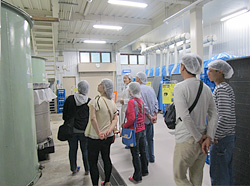
◆ Please come 10 minutes before the tour start time.
If you miss the start time of the tour without contacting us, the tour will be cancelled.
*You may not be able to observe the facility due to circumstances such as facilities.
* Reservations will end when the capacity is reached. note that
List of Japanese Sake Related Awards
| 2023 | ♦ 17th FEMINALISE World Wine Competition 2023 [Junmai Ginjo Category] ・Yamahai Ginjo Junmai・・・Gold Award ♦KAN SAKE AWARD 2023 [Premium Warmed Sake Category]・Yamahai Ginjo Junmai: Best Gold Award ・Yamahai Junmai: Gold Award [ Value for money warmed sake category] ・RICH Yamahai ・・・Best Gold Award |
| 2022 | ♦THE Fine SAKE Award, Japan 2022 [Premium Junmai Category]・Yamahai Ginjo Junmai・・・Gold Prize ・Kimoto Ginjo Junmai・・・Gold Prize ♦16th FEMINALISE World Wine Competition 2022 [Junmai Ginjo Category]・Yamahai Ginjo Junmai: Gold Award ♦KAN SAKE AWARD 2022 [Premium Warm Sake Category]・Yamahai Ginjo Junmai: Best Gold Award ・Kimoto Ginjo Junmai: Gold Award [Value for money hot sake category] ・Kimoto Karakuchi ・・・Gold Award |
| 2021 | ♦Delicious Sake in a Wine Glass Award 2021 [Premium Daiginjo Category]・Yamahai Daiginjo・・・Gold Award ♦The 15th Feminaries World Wine Competition 2021 [Junmai Ginjo Category]・Yamahai Ginjo Junmai・・・Gold Award ♦ Osaka Regional Taxation Bureau Refined Sake Appraisal [Refined Sake for Hot Sake] ・Pride of Tajima・・・Excellence Award |
| 2020 | ◆International Wine Challenge2020「SAKE Category」 < Junmai Category > ・Yamahai Junmai … Gold < Futsushu Category > ・Kimoto Karakuchi … Gold |
| 2020 | ♦Osaka Sake Awards 2020 (Osaka Regional Taxation Bureau) <Kan-zake Category (warmed sake)> ・Yamahai Jikomi Tajima no Hokori … Excellence Prize |
| 2019 | ♦Osaka Sake Awards 2019 (Osaka Regional Taxation Bureau) <Kan-zake Category (warmed sake)> ・Yamahai Jikomi Tajima no Hokori … Excellence Prize ♦International Sake Challenge 2019 ・Kimoto Karakuchi … Trophy ・Yamahai Jikomi Tajima no Hokori … Silver ・Kimoto Junmai … Silver ♦Kan Sake Award 2019 <Premium Kanzake Category> ・Yamahai Ginjo Junmai … Gold ・Kimoto Ginjo Junmai … Gold ♦U.S.National Sake Appraisal 2019 < Ginjo Category > ・Kimoto Ginjo Junmai… Silver ・Yamahai Ginjo Junmai… Silver < Junmai Category > ・Kimoto Junmai… Silver ・Yamahai Junmai… Silver ♦London Sake Challenge 2019 < Junmai Daiginjo Category > ・Kimoto Junmai Daiginjo Fukuchiya… Silver < Daiginjo Category > ・Kimoto Daiginjo Fukuchiya… Gold ・Yamahai Daiginjo… Silver < Junmai Ginjo Category > ・Yamahai Ginjo Junmai… Silver ・Kimoto Ginjo Junmai… Silver < Junmai Category > ・Kimoto Junmai… Pratina ・Yamahai Junmai… Gold < Futsushu Category > ・Kimoto Karakuchi… Silver ・Yamahai Jikomi Tajima no Hokori… Silver < Ume Sake Category > ・Kodawari no Umesake… Silver ◆Wine Glass de Oishii Sake Award 2019 < Daiginjo Category > ・ Kimoto Junmai Daiginjo Fukuchiya ... Gold ・Kimoto Daiginjo Fukuchiya ... Gold < Premium Junmai Category > ・ Kimoto Ginjo Junmai ... Gold ◆13th World Wine Competition FÉ’MINALISE2019 ・Kodawari no Umesake … Gold ◆International Wine Challenge2019「SAKE Category」 < Junmai Ginjo Category > ・Yamahai Ginjo Junmai … Gold < Junmai Category > ・Kimoto Junmai … Silver ・Yamahai Junmai … Silver < Futsushu Category > ・Kimoto Karakuchi … Silver ・Yamahai Jikomi Tajima no Hokori … Silver |
| 2018 | ◆Wine Glass de Oishii Sake Award 2018 < Premium Junmai Category > ・ Yamahai Ginjo Junmai ...Gold ◆Kura Master 2018 < Junmai Category > ・Kimoto Junmai... Gold ◆National Kanzake Contest 2018 < Oneuchi Nurukan Category > ・Kimoto Junmai...Gold ・Yamahai Jikomi Tajima no Hokori...Gold ◆International Sake Challenge2018 < Junmai ginjo Category > ・Yamahai Ginjo Junmai...Gold < Kimoto・Yamahai Category > ・Kimoto Karakuchi...Gold ・Yamahai Jikomi Tajima no Hokori...Gold ◆Osaka Sake Awards 2017 (Osaka Regional Taxation Bureau) < Kan-zake Category (warmed sake)> ・Yamahai Jikomi Tajima no Hokori ... Excellence Prize |
| 2017 | ◆72th Tajima Toji Jijoshu Kenkyukai2017 < Futsushu Category > ・Yamahai Jikomi Tajima no Hokori Highest honor(Hyogo Governor's Award) < Junmai Category > ・Yamahai Ginjo Junmai Highest honor(Hyogo Governor's Award) ◆Wine Glass de Oishii Sake Award2017 < Sparkling Sake Category > ・Yamahai Junmai Happo Nigori Sake Kingyo...Gold ◆National Kanzake Contest 2017 < Premium Kanzake Category > ・Yamahai Jikomi Tajima no Hokori...Gold ◆U.S.National Sake Appraisal 2017 < Ginjo Category > ・Yamahai Ginjo Junmai...Gold < Junmai Category > ・Yamahai Junmai...Gold ・Kimoto Junmai...Silver ◆International SakeChallenge 2017 < Kimoto・Yamahai Category > ・Yamahai Ginjo Junmai...Silver ・Kimoto Karakuchi...Silver ◆Osaka Sake Awards 2017 (Osaka Regional Taxation Bureau) < Kan-zake Category (warmed sake) > ・Kimoto Karakuchi ... Excellence Prize |
| 2016 | ◆National Kanzake Contest 2016 < Premium Kanzake Category > ・Kimoto Junmai...Gold ・Kimoto Karakuchi...Gold ◆International SakeChallenge 2016 < Kimoto・Yamahai Category > ・Kimoto Ginjo Junmai...Silver ・Yamahai Ginjo Junmai...Silver ・Yamahai Tokubetsu Junmai...Silver ◆U.S.National Sake Appraisal 2016 < Junmai Category > ・Yamahai Tokubetsu Junmai...Silver |
Other Awards
| 2009 | Furusato Kigyo Taisho (Prime Minister Award) Japan Foundation For Regional Vitalization |
| 2009 | Tajima Sangyo Award |

![English Page[Kasumitsuru]](https://www.fukuchiya.co.jp/60011505/wp-content/uploads/2023/04/body_bg_15-1.png)
